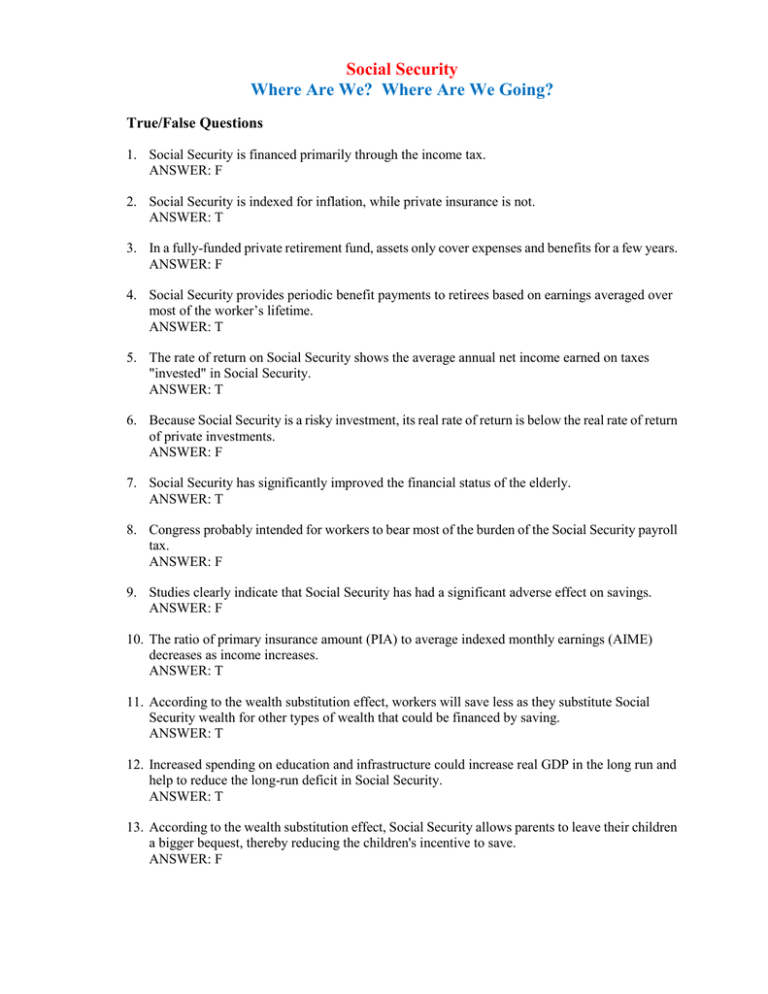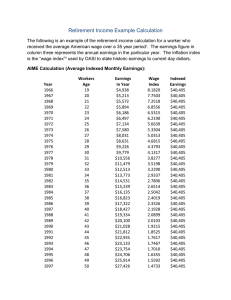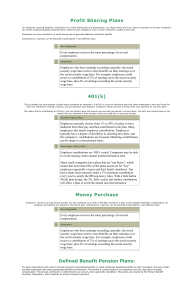Social Security Where Are We?
advertisement

Social Security Where Are We? Where Are We Going? True/False Questions 1. Social Security is financed primarily through the income tax. ANSWER: F 2. Social Security is indexed for inflation, while private insurance is not. ANSWER: T 3. In a fully-funded private retirement fund, assets only cover expenses and benefits for a few years. ANSWER: F 4. Social Security provides periodic benefit payments to retirees based on earnings averaged over most of the worker’s lifetime. ANSWER: T 5. The rate of return on Social Security shows the average annual net income earned on taxes "invested" in Social Security. ANSWER: T 6. Because Social Security is a risky investment, its real rate of return is below the real rate of return of private investments. ANSWER: F 7. Social Security has significantly improved the financial status of the elderly. ANSWER: T 8. Congress probably intended for workers to bear most of the burden of the Social Security payroll tax. ANSWER: F 9. Studies clearly indicate that Social Security has had a significant adverse effect on savings. ANSWER: F 10. The ratio of primary insurance amount (PIA) to average indexed monthly earnings (AIME) decreases as income increases. ANSWER: T 11. According to the wealth substitution effect, workers will save less as they substitute Social Security wealth for other types of wealth that could be financed by saving. ANSWER: T 12. Increased spending on education and infrastructure could increase real GDP in the long run and help to reduce the long-run deficit in Social Security. ANSWER: T 13. According to the wealth substitution effect, Social Security allows parents to leave their children a bigger bequest, thereby reducing the children's incentive to save. ANSWER: F 14. If the supply curve of labor is vertical, then wage decreases will have no effect on the number of hours worked. ANSWER: T 15. Most private retirement plans are indexed for inflation and receive preferential tax treatment in the federal tax codes. ANSWER: F 16. The income effect of a wage decrease says that when wages fall, workers must work more hours in order to make up for their wage reduction. ANSWER: T 17. Social Security may result in an increase in the supply of labor because it induces workers to retire at an earlier age. ANSWER: F 18. Projections show the OASI Trust Fund being exhausted by the year 2005. ANSWER: F 19. Increasing the retirement age for OASI has been one option suggested for dealing with the exhaustion of the OASI Trust Fund. ANSWER: T 20. According to Martin Feldstein, Social Security has not had a significant impact on household savings. ANSWER: F 21. Estimates indicate that more than 45 percent of the elderly would have incomes below the federal poverty line in the absence of Social Security. ANSWER: T 22. With Social Security, the poverty rate for the elderly-10.5 percent-was less than the poverty rate for the population as a whole-12.7 percent-in 1998. ANSWER: T Multiple-Choice Questions 1. In its broadest sense, Social Security refers to: a. all the social insurance programs established by the Social Security Act. b. only the old-age and survivors' insurance program administered by the Social Security Administration. c. all public assistance programs administered by the federal government. d. all social insurance programs administered by the federal government. ANSWER: a 2. Most of the revenues for Social Security are generated by: a. the payroll tax. b. the personal income tax. c. state sales taxes. d. excise taxes. ANSWER: a 3. Which of the following is characteristic of Social Security? a. Its benefits are indexed for inflation. b. It has historically been a pay-as-you-go insurance plan. c. Its benefits are not based solely on of individual contribution. d. All of the above. ANSWER: d 4. In a fully-funded private retirement plan: a. benefits are paid only if assets are sufficient to cover all obligations. b. assets tend to only be large enough to cover benefits and expenditures for a year or two. c. assets tend to be large enough to cover benefits and expenditures for many years. d. benefits are small relative to the size of the fund from which benefits are paid. ANSWER: c 5. Social Security benefits are: a. indexed to account for changes in average national wages between the year the earnings were realized and age 55. b. indexed to account for changes in average national wages between the year the earnings were realized and age 60. c. indexed to account for changes in average national wages between the year the earnings were realized and age 65. d. indexed to account for changes in average national wages between the year the earnings were realized and age 70. ANSWER: b 6. The difference between Social Security and private insurance is: a. private insurance is a pay-as-you-go system while Social Security is fully-funded. b. private insurance is not indexed for inflation, while Social Security is. c. private insurance benefits are subject to an earnings penalty, Social Security benefits are not. d. private insurance benefits are treated more favorably in the tax code than Social Security benefits. ANSWER: b 7. The sum of 35 years of indexed earnings divided by 420 determines: a. the rate of return. b. the social benefit. c. primary insurance amount. d. average indexed monthly earnings. ANSWER: d 8. The normal retirement age for a person born before 1968 is: a. 65 year. b. 65 years and 2 months. c. 65 years and 4 months. d. 65 years and 4 months. ANSWER: a 9. The normal retirement age for a person born in 1960 is: a. 65 year and 2 months. b. 65 years and 6 months. c. 66 years and 6 months. d. 67 years. ANSWER: d 10. Which of the following statements concerning Social Security is correct? a. Workers and employers appear to share the burden of the payroll tax equally. b. Rates of return based only on monetary benefits and costs average 4-5%. c. Rates of return based only on monetary benefits and costs average 1-2%. d. There are no non-monetary benefits associated with Social Security. ANSWER: c 11. Which statement concerning pension plans in other countries is correct? a. Pension plans in countries such as Canada and Germany appear to be in better financial shape than Social Security in the U.S. b. Pension plans in countries such as Japan and the United Kingdom appear to be in better financial shape than Social Security in the U.S. c. Social Security and pension plans in the other developed countries face almost exactly the same financial situation. d. Pension plans in other developed countries are in worse financial shape than Social Security in the U.S. ANSWER: d 12. It is difficult to compare the rate of return on Social Security to the rate of return on private investments because: a. rates of return on Social Security are higher because it is a riskier investment. b. rates of return on Social Security are lower because it is a less risky investment. c. private investments provide insurance against old-age poverty. d. private investments are indexed for inflation. ANSWER: b 13. An effect that induces workers to substitute Social Security wealth for other types of wealth that could be financed by saving is: a. the wealth substitution effect. b. the induced retirement effect. c. the bequest effect. d. the income effect. ANSWER: a 14. The tendency of Social Security benefits to encourage people to retire earlier than they would in the absence of these benefits is: a. the wealth substitution effect. b. the induced retirement effect. c. the bequest effect. d. the income effect. ANSWER: b 15. Which of the following statements is false? a. If started now, the long-run Social Security deficit could be avoided by reducing benefits by as little as $163 per year per retiree. b. If started now, the long-run Social Security deficit could be avoided by raising taxes. c. If all surplus funds in the Social Security Trust Fund were invested in private securities, the long-run Social Security deficit would be eliminated. d. An adjustment to the Consumer Price Index of just 1% could reduce the long-run Social Security deficit by 60%. ANSWER: c 16. Which of the following would be most likely to cause savings to fall in response to the payment of Social Security benefits? a. the induced retirement effect. b. the wealth substitution effect. c. the bequest effect. d. the increased wealth effect. ANSWER: b 17. Studies indicate that Social Security benefits have had: a. a significant positive effect on savings. b. a significant negative effect on savings. c. a significant negative effect on the savings of the current generation of workers, but have had no effect on the savings of past generations of workers. d. inconclusive results as to Social Security's effect on savings. ANSWER: d 18. Which projection of the Social Security long-run deficit is viewed as the “best estimate?” a. Alternative II b. Alterative III c. Alternative I d. Alternative IV ANSWER: a 19. Which best describes the predictions of the “best estimate” of the long-run Social Security deficit? a. The Trust Fund will be exhausted by the year 2045. b. The Trust Fund will be exhausted by the year 2041. c. The Trust Fund will be exhausted by the year 2023. d. None of the above. ANSWER: b 20. It is generally thought that the earnings penalty will: a. only have an impact on the number of hours that younger workers are willing to work. b. have a large negative impact on the number of hours that older workers are willing to work. c. have an insignificant effect on the number of hours that older workers are willing to work. d. cause older workers to retire from the labor force at an earlier age. ANSWER: c 21. Which of the following may account for the decrease in the labor force participation rate of men 65 and older? a. Social Security benefits. b. Growth in private pensions. c. Rising income. d. All of the above. ANSWER: d 22. Among the factors accounting for the rapid build-up of the Social Security trust fund is: a. a significant increase in fertility rates resulting in an increase in the size of the labor force. b. a significant fall in fertility rates. c. a decrease in the number of people who are self-employed. d. a large increase in the labor force due to the entrance of baby-boomers. ANSWER: d 23. In order to deal with the exhaustion of the Social Security Trust Fund: a. the retirement age for OASI could be increased. b. Social Security should become a fully-funded system. c. the retirement age for OASI could be decreased. d. the Social Security tax base could be decreased. ANSWER: a Critical Thinking Multiple Choice 24. An insurance plan in which assets are only large enough to cover benefits and expenses for a few years is called: a. a pay-as-you-go insurance plan. b. a fully-funded insurance plan. c. an annual-contribution insurance plan. d. a buffer fund. ANSWER: a 25. An insurance plan in which assets are large enough to cover benefits and expenses for several years is described as: a. a pay-as-you-go insurance plan. b. a fully-funded insurance plan. c. an annual-contribution insurance plan. d. a buffer fund. ANSWER: b 26. An insurance plan in which benefits are determined based on individual contribution, but not other factors, is referred to as: a. a defined benefit plan. b. a contingency fund plan. c. a defined contribution plan. d. a fully-funded fund. ANSWER: c 27. Sara earned $10,000 at age 40. Assume that the average national wage when Sara was age 60 is $39,800, and is $15,000 when she was age 40. The indexed value of earnings is: a. $26,350. b. $27,350. c. $26,530. d. $25,400. ANSWER: c 28. Mark and Jim have contributed the same amount to Social Security. Mark's spouse did not work while Jim's spouse was in the labor force. In terms of their real rate of return earned on Social Security, we would expect to find: a. Jim's real rate of return to exceed Mark's. b. Mark's real rate of return to exceed Jim's. c. Mark's and Jim's real rates of return to be the same. d. Jim's real rate of return to exceed Mark's during the initial years in which benefits are received. However, after the tenth year, Mark's real rate of return will exceed Jim's. ANSWER: b 29. Joan knows she will be receiving Social Security benefits upon retirement. This allows her to save less of her income and increase consumption. This is an example of: a. the wealth substitution effect. b. the induced retirement effect. c. the bequest effect. d. the mitigated savings effect. ANSWER: a 30. Social Security benefits cause Michael to retire at age 65 instead of 75. In order to finance the longer period of retirement Michael decides to increase his rate of savings. This is an example of the: a. induced wealth effect. b. bequest effect. c. early retirement effect. d. induced retirement effect. ANSWER: d 31. Penny’s wage rate decreases because of the imposition of a payroll tax, Penny decides to work fewer hours. This is an example of the: a. induced savings effect. b. income effect of a wage decrease. c. substitution effect of a wage decrease. d. reverse-endowment effect of a wage decrease. ANSWER: c 32. A decrease in the wage rate will have a smaller impact on hours worked if the: a. labor supply curve is upward sloping. b. labor supply curve is vertical. c. labor supply curve is horizontal. d. labor supply curve is negatively sloped. ANSWER: b 33. According to Martin Feldstein, a. Potential output in the US was not affected by Social Security. b. The labor supply curve is vertical. c. Potential output in the US was reduced by $130 billion in 1999. d. None of the above are correct. ANSWER: c Use the following diagram to answer questions 34 – 37. Wage per Hour (Dollars) S1 W1 W2 C B K G F Da Db H1 Hours W orked 34. Suppose there is no payroll tax in effect, which demand curve represents the value of the output produced by labor? a. Da. b. Db. c. S1 d. This cannot be determined from the above diagram. ANSWER: a 35. Suppose a payroll tax of 7% is imposed. By how much will the wage rate of the workers fall? a. Wage rates will not fall. b. 7% c. 10.6% d. This cannot be determined from the above diagram. ANSWER: b 36. In the absence of a payroll tax, labors’ earning will equal the area: a. G + K + F b. G + K c. F d. G + K + F + B + C ANSWER: a 37. The area of G + K represents: a. labor’s earnings in the absence of a payroll tax. b. the amount of the payroll tax remitted to the federal government. c. labor’s earnings after a payroll tax. d. value of the output produced by labor. ANSWER: b Essay and Discussion Questions 1. "The prospect of Social Security benefits has induced workers to retire at earlier ages." Is this statement true or false? Defend your answer. It is true that the labor force participation rate for men age 65 and older has fallen significantly since 1950; however, this decline is not due solely to the payment of Social Security benefits. A number of factors such as increased income, the growth of private pensions, the increased availability of government transfers, and changing life styles have all contributed to the decline. Thus, while Social Security may be responsible for some decline in labor force participation rates of older workers, it is not certain how much of the decline can be attributed to social security. 2. Evaluate the following statement. "The real rate of return on certain private investments far exceeds the return that can be earned on Social Security. People would be better off if government would allow them to take the money they would have paid into Social Security and invest it in the private sector." The student should recognize that this statement is not necessarily true. First, many private investments offer a rate of return comparable to the rate of return on Social Security. Second, private investments involve some risk. Part of the higher return associated with these investments is to compensate the investor for risk. Third, Social Security offers some insurance against poverty. Private investments offer no such protection. Finally, unlike private investments, Social Security benefits are indexed for inflation. 3. Who bears the burden of the Social Security payroll tax. The student should recognize that economists believe that the supply of labor curve is vertical, or nearly so. This creates a situation where the lower wage that is a result of the payroll tax will not reduce hours worked by labor. Because workers are unwilling or unable to reduce hours worked when the wage decreases, employers are able to shift the entire burden of the tax onto the workers without fear that output will be reduced. 4. "Social Security benefits have significantly lowered savings in the United States." Is this statement true or false? Defend your answer. The impact of Social Security benefits on savings is ambiguous. The wealth substitution effect does tend to lower savings. On the other hand, the induced retirement effect and the bequest effect both work to increase savings. If children normally bear the burden of caring for aged parents our of their current earnings, then social security will have no impact on savings. Theoretically, there is no clear answer as to how Social Security will impact savings. Studies provide no convincing evidence. Some studies show that Social Security has had a significant negative impact on savings. Others indicate only a small negative impact on savings. Some studies even show Social Security having a positive impact on savings. At the present time, we do not know for certain how much Social Security has impacted savings in the United States. 5. Evaluate the following statement: "Because the Social Security earnings penalty lowers the financial reward for each hour worked when earnings exceed the penalty-free amount, it reduces the number of hours worked by the elderly." This statement is not necessarily true. The earnings penalty does lower the financial reward for each hour worked, thereby reducing the number of hours worked. On the other hand, the penalty, through its negative impact on a worker's wage, also reduces a worker's income. Some workers respond to this by increasing the number of hours worked. 6. Calculate the PIA for a person born in 1940 and retiring at normal retirement age (65 years, 6 Months) who earned $230,000 while working. ______________________________________________________________________________ TABLE 1 Determination of Initial Social Security Benefits (PIA) for Three Individuals Born in 1940 and Retiring at Normal Retirement Age (65 years, 6 Months) Actual Indexed 1st 2nd 3rd Wages Wages AIME Bracket Bracket Bracket PIA PIA/AIME $230,000 $420,000 $1,000 $533 $131 $0 ____ 0.66 $580,000 $1,050,000 $2,500 $533 $611 $0 $824 0.46 $1,400,000 $2,520,000 $6,000 $533 $952 $365 $1850 0.31 ______________________________________________________________________________ The formula for determining the basic benefit or PIA reflects the year a person was born. For someone born in 1940 - a person who will be 62 in 2002 - the PIA formula is: PIA = .9 (First $592 AIME) + .32 ($592 <AIME< $3567) + .15 (AIME over $3567). The above table shows the results of calculations based on this formula for three hypothetical retirees. The first is a low-wage worker who earned $230,000 while working. Application of the average wage index to actual wages would yield indexed earnings from 1.8 to 2.0 times higher than actual wages. We assume in this case that they would be $420,000, an amount that falls in the expected range. Division of earnings by 420 gives AIME of $1,000. Application of the PIA formula to this AIME yields $533 in the first bracket (.9 X $592) and $131 in the second bracket (.32 X ($1,000 - $592). The third bracket does not apply in this case. The net result is a PIA or initial monthly Social Security benefit upon retirement of $664.





